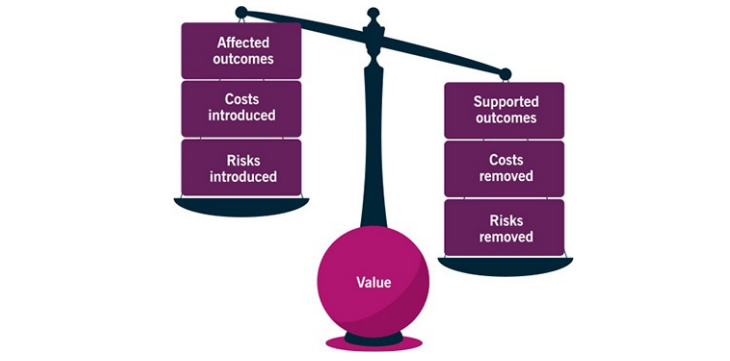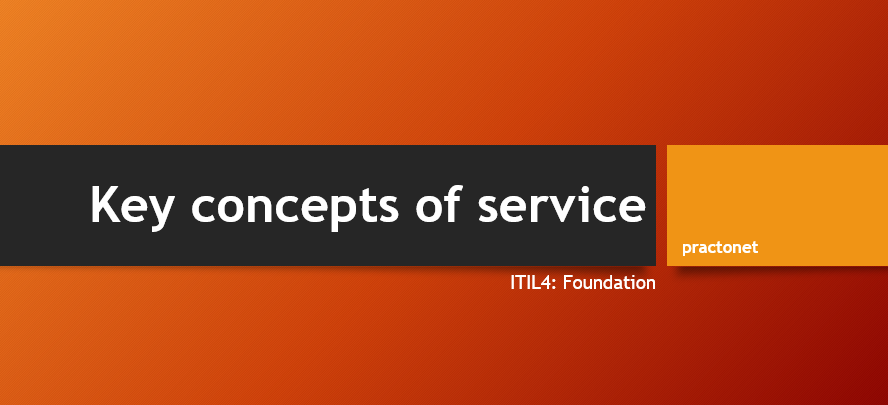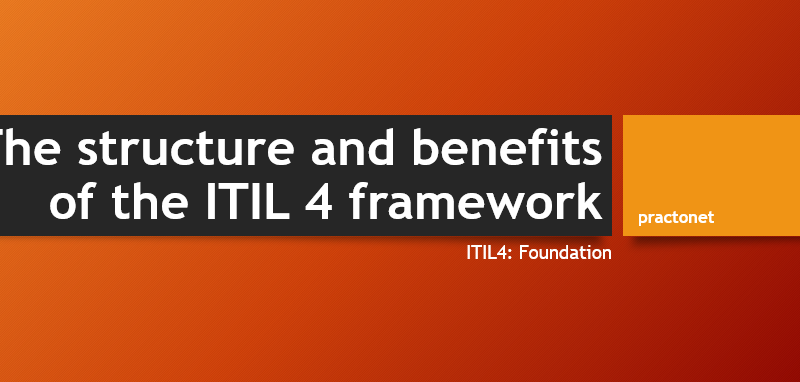A shared understanding of the key concepts and terminology of ITIL by organizations and individuals is critical to the effective use of this guidance to address real-world service management challenges. To that end, this chapter explains some of the most important concepts of service management, including:
- The nature of value and value co-creation
- Organizations, service providers, service consumers, and other stakeholders
- Products and services
- Service relationships
- Value: outcomes, costs, and risks.
Value and value co-creation
The term ‘value’ is used regularly in service management, and it is a key focus of ITIL 4; it must therefore be clearly defined. Value: The perceived benefits, usefulness, and importance of something.
Inherent in this definition is the understanding that value is subject to the perception of the stakeholders, whether they be the customers or consumers of a service, or part of the service provider organization(s). Value can be subjective.
Value Co-Creation
There was a time when organizations self-identifying as ‘service providers’ saw their role as delivering value to their customers in much the same way that a package is delivered to a building by a delivery company. This view treated the relationship between the service provider and the service consumer as mono-directional and distant. The provider delivers the service and the consumer receives value; the consumer plays no role in the creation of value for themselves. This fails to take into consideration the highly complex and interdependent service relationships that exist in reality.
Increasingly, organizations recognize that value is co-created through an active collaboration between providers and consumers, as well as other organizations that are part of the relevant service relationships. Providers should no longer attempt to work in isolation to define what will be of value to their customers and users, but actively seek to establish mutually beneficial, interactive relationships with their consumers, empowering them to be creative collaborators in the service value chain. Stakeholders across the service value chain contribute to the definition of requirements, the design of service solutions and even to the service creation and/or provisioning itself.
Organizations, Service providers, Service consumers, and other Stakeholders
In service management there are many different kinds of stakeholder, each of which must be understood in the context of the creation of value in the form of services. First, the term ‘organization’ needs to be defined.
Organization
Organization is a person or a group of people that has its own functions with responsibilities, authorities, and relationships to achieve its objectives.
Organizations vary in size and complexity, and in their relation to legal entities, from a single person or a team to a complex network of legal entities united by common objectives, relationships, and authorities. As societies and economies evolve, the relationships between and within organizations become more complex. Each organization depends on others in its operation and development. Organizations may hold different roles, depending on the perspective under discussion. For example, an organization that coordinates adventure vacations can fill the role of a service provider to a travel agent when it sells a vacation, while simultaneously filling the role of service consumer when it purchases airport transfers to add to their vacation packages.
Service providers
When provisioning services, an organization takes on the role of the service provider. The provider can be external to the consumer’s organization, or they can both be part of the same organization.
In the most traditional views of ITSM, the provider organization is seen as the IT department of a company, and the other departments or other functional units in the company are regarded as the consumers. This is, however, only one very simple provider-consumer model. A provider could be selling services on the open market to other businesses, to individual consumers, or it could be part of a service alliance, collaborating to provide services to consumer organizations. The key is that the organization in the provider role has a clear understanding of who its consumers are in a given situation and who the other stakeholders are in the associated service relationships.
Service consumers
When receiving services, an organization takes on the role of the service consumer.
Service consumer is a generic role that is used to simplify the definition and description of the structure of service relationships. In practice, there are more specific roles involved in service consumption, such as customers, users, and sponsors. These roles can be separate or combined.
- Customer A person who defines the requirements for a service and takes responsibility for the outcomes of service consumption.
- User A person who uses services.
- Sponsor A person who authorizes budget for service consumption.
Other stakeholders
A key focus of service management, and of ITIL, is the way that organizations cocreate value with their consumers through service relationships. Beyond the consumer and provider roles, there are usually many other stakeholders that are important to value creation. Examples include individual employees of the provider organization, partners and suppliers, investors and shareholders, government organizations such as regulators, and social groups. For the success, and even the continued existence of an organization, it is important that relationships with all key stakeholders are understood and managed. If stakeholders are unhappy with what the organization does or how it does it, the provider’s relationships with its consumers can be in jeopardy.
Products and services create value for stakeholders in a number of ways. Some are quite direct such as the generation of revenue, while others are more indirect such as employee experience.
Products and services
The central component of service management is, of course, the service. The nature of services will now be considered, and an outline given of the relationship between a service and a product.
Configuring resources for value creation
Services is a means of enabling value co-creation by facilitating outcomes that customers want to achieve, without the customer having to manage specific costs and risks. Product is a configuration of an organization’s resources designed to offer value for a consumer.
The services that an organization provides are based on one or more of its products. Organizations own or have access to a variety of resources, including people, information and technology, value streams and processes, and partners and suppliers. Products are configurations of these resources, created by the organization, that will potentially be valuable for its customers.
Each product that an organization offers is created with a number of target consumer groups in mind, and the products will be tailored to appeal to, and meet the needs of, these groups. A product is not exclusive to one consumer group, and can be used to address the needs of several different groups. For example, a software service can be offered as a ‘lite’ version, for individual users, or as a more comprehensive corporate version.
Products are typically complex and are not fully visible to the consumer. The portion of a product that the consumer actually sees does not always represent all of the components that comprise the product and support its delivery. Organizations define which product components their consumers see, and tailor them to suit their target consumer groups.
Service offerings
Service offering is a formal description of one or more services, designed to address the needs of a target consumer group. A service offering may include goods, access to resources, and service actions. Service providers present their services to consumers in the form of service offerings, which describe one or more services based on one or more products.
Service offerings may include:
- Goods to be supplied to a consumer (for example, a mobile phone). Goods are supposed to be transferred from the provider to the consumer, with the consumer taking the responsibility for their future use
- Access to resources granted or licensed to a consumer under agreed terms and conditions (for example, to the mobile network, or to the network storage). The resources remain under the provider’s control and can be accessed by the consumer only during the agreed service consumption period
- Service actions performed to address a consumer’s needs (for example, user support). These actions are performed by the service provider according to the agreement with the consumer.
Services are offered to target consumer groups, and those groups may be either internal or external to the service provider organization. Different offerings can be created based on the same product, which allows it to be used in multiple ways to address the needs of different consumer groups. For example, a software service can be offered as a limited free version, or as a comprehensive paid-for version, based on one product of the service provider.
Service relationships
To create value, an organization must do more than simply provide a service. It must also cooperate with the consumers in service relationships. Service relationships are established between two or more organizations to co-create value. In a service relationship, organizations will take on the roles of service providers or service consumers. The two roles are not mutually exclusive, and organizations typically both provide and consume a number of services at any given time.
The service relationship model
When services are delivered by the provider, they create new resources for service consumers, or modify their existing ones. For example:
- A training service improves the skills of the consumer’s employees
- A broadband service allows the consumer’s computers to communicate
- A car-hire service enables the consumer’s staff to visit clients
- A software development service creates a new application for the service consumer.

The service consumer can use its new or modified resources to create its own products to address the needs of another target consumer group, thus becoming a service provider.
Value: outcomes, costs, and risks
Service relationships are perceived as valuable only when they have more positive effects than negative. Outcomes, and how they influence and are influenced by the other elements, will now be discussed. Achieving desired outcomes requires resources (and therefore costs) and is often associated with risks. Service providers help their consumers to achieve outcomes, and in doing so, take on some of the associated risks and costs . On the other hand, service relationships can introduce new risks and costs, and in some cases, can negatively affect some of the intended outcomes, while supporting others.

Outcomes
Acting as a service provider, an organization produces outputs that help its consumers to achieve certain outcomes. Output A tangible or intangible deliverable of an activity. Outcome A result for a stakeholder enabled by one or more outputs.
It is important to be clear about the difference between outputs and outcomes. For example, one output of a wedding photography service may be an album in which selected photos are artfully arranged. The outcome of the service, however, is the preservation of memories and the ability of the couple and their family and friends to easily recall those memories by looking at the album.
Depending on the relationship between the provider and the consumer, it can be difficult for the provider to fully understand the outcomes that the consumer wants to achieve. In some cases they will work together to define the desired outcomes. For example, business relationship managers (BRMs) in internal IT or HR departments may regularly talk with customers and discuss their needs and expectations. In other cases, the consumers articulate their expectations quite clearly, and the provider expects them to do so, such as when standardized services are offered to a wide consumer group. This is how mobile operators, broadband service providers, and transport companies usually operate. Finally, some service providers predict or even create demand for certain outcomes, forming a target group for their services. This may happen with innovative services addressing needs that consumers were not even aware of before. Examples of this include social networks or smart home solutions.
Costs
Cost is amount of money spent on a specific activity or resource. From the service consumer’s perspective, there are two types of cost involved in service relationships:
- costs removed from the consumer by the service (a part of the value proposition). This may include costs of staff, technology, and other resources, which the consumer does not need to provide
- costs imposed on the consumer by the service (the costs of service consumption). The total cost of consuming a service includes the price charged by the service provider (if applicable), plus other costs such as staff training, costs of network utilization, procurement, etc. Some consumers describe this as what they have to ‘invest’ to consume the service.
Both types of cost are considered when the consumer assesses the value which they expect the service to create. To ensure that the correct decisions are made about the service relationship, it is important that both types of cost are fully understood.
From the provider’s perspective, a full and correct understanding of the cost of service provision is essential. Providers need to ensure that services are delivered within budget constraints and meet the financial expectations of the organization.
Risks
Risk is possible event that could cause harm or loss, or make it more difficult to achieve objectives. Can also be defined as uncertainty of outcome, and can be used in the context of measuring the probability of positive outcomes as well as negative outcomes.
As with costs, there are two types of risk that are of concern to service consumers:
- Risks removed from a consumer by the service (part of the value proposition). These may include failure of the consumer’s server hardware or lack of staff availability. In some cases, a service may only reduce a consumer’s risks, but the consumer may determine that this reduction is sufficient to support the value proposition.
- Risks imposed on a consumer by the service (risks of service consumption). An example of this would be a service provider ceasing to trade, or experiencing a security breach.
It is the duty of the provider to manage the detailed level of risk on behalf of the consumer. This should be handled based on a balance of what matters most to the consumer and to the provider. The consumer contributes to the reduction of risk through:
- Actively participating in the definition of the requirements of the service and the clarification of its required outcomes
- Clearly communicating the critical success factors (CSFs) and constraints that apply to the service
- Ensuring the provider has access to the necessary resources of the consumer throughout the service relationship.





